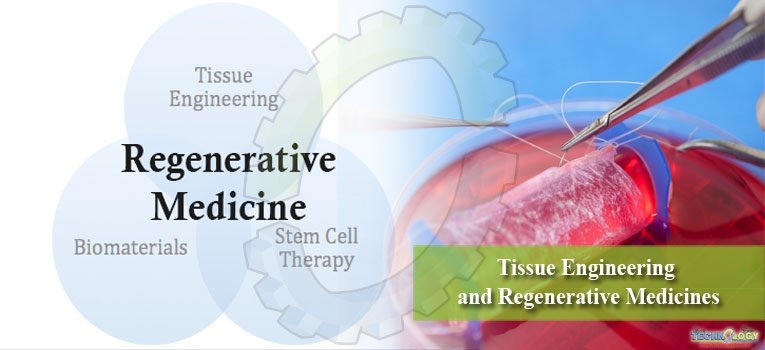Currently, patients suffering from injured and diseased organs can be treated with transplanted organs. Though, there is a shortage of organ donors that is deteriorating yearly as the populace ages and new cases of organ failure increases.

Researchers in the field of regenerative medicine and tissue engineering are currently applying the standards of cell transplantation, material science, and bio engineering to engineer organic substitutes that will reinstate and retain regular function in injured and diseased tissues.
Regenerative medicine is a versatile discipline that applies life science principles and engineering to support regeneration, can possibly retain injured and diseased tissues and entire organ. The normal mechanisms requisite to obtain a functional regeneration of tissues may contain biodegradable scaffolds, growth factors or drugs and various cell types (may be heterologous or autologous) that can be cultured in bioreactor before implantation into the patient.
READ MORE ABOUT:
In therapeutic cloning, nucleus from a donor cell is transferred into an enucleated oocyte in order to extract PESC (pluripotent embryonic stem cells), offers a possibly unlimited source of cells for tissue engineering applications. TE and RM offers a platform in light of molecular, biochemical, cellular and biomaterials components to specifically coordinate tissue healing mechanisms for better defect regeneration.
Numerous innovative TE and RE tools are being developed, for example multi-functionalized biomaterials, nanomaterial’s for drug delivery system or engineered stem cells that have the prospective to intervene anticancer effects, act synergistically with presently used chemotherapeutics or radiotherapy regimens and decrease their side effects.
Recently, researchers became conscious that tissue engineering and regenerative medicine approaches may be used to develop customized diagnostic tools and clinically related disease models for the patients of cancer.
READ MORE ABOUT:
Clinical therapies using tissue engineering and regenerative medicines:
The first FDA approved carticel, a biologic product, utilizes autologous chondrocytes for the treatment of focal articular cartilage defects. Autologous chondrocytes are isolated from articular cartilage, lingering ex vivo, and implanted at the injury site, ensuing in recovery as compared with that observed using other techniques (e.g., micro fracture and mosaicplasty).
Similarly dental stem cells are mesenchyme stem cells like populations with self regeneration ability and multi-differentiation potential. Dental follicle precursor cells and stem cells from exfoliated deciduous teeth have been altogether observed in regenerative medicine and tissue engineering as autologous stem cells therapies and have indicated remarkable therapeutic capabilities in cardiovascular, oro-facial, neurologic, hepatic, renal corneal, auto-immune conditions and muscular dystrophy in both animal and human models, and some of them in human clinical trials.
Preclinical analysis with different cell types including mesenchyme stem cells, dermal fibroblast and tendocytes have been assessed for tendon regeneration or repair. LaViv, which includes the injection of autologous fibroblasts to enhance the presence of nasolabial wrinkles; Celution, a medicinal instrument that isolates cells from adipose tissue derivative of liposuction; Epicel, autologous keratinocytes for extreme burn wounds; and the culture of cord blood to obtain hematopoietic stem cells progenitor.
MSCs/Stromal Cells in Regenerative Medicine:
MSCs, the multilineage SC, differentiate just to tissue of mesodermal origin, which incorporates ligaments, bone, ligament, tendons, muscles, and neurons. The utilization of MSCs in regenerative medication can be summed up from progressing clinical preliminaries, staging through various condition of completions, looked into somewhere else. MSCs likewise can possibly recover liver tissue and treat liver cirrhosis. In vitro chondrogenic, osteogenic, and adipogenic capability of MSCs advocates restorative uses of MSCs in orthopedic wounds.
UCSCs in Regenerative Medicine:
Umbilical cord is rich source of hematopoietic stem cells and mesenchyme stem cells, which have vast regenerative potential. Umbilical cord stem cells are the best options for those patients who need donors with completely coordinated HLA composing for peripheral blood and PBMCs and bone marrow.
The field of stem cell is progressing rapidly, opening new possibilities for such type of treatments. The rapidly prompting and multidisciplinary field of regenerative medicine is at the cutting edge of translational research. Bone marrow cell medicines are remarkably innovations in regenerative medicine and stem cell therapy.
Therapies at the preclinical stage and in clinical testing:
An expansive scope of methodologies at both the preclinical and clinical phases of research is at present being studied. The resulting subsections will diagram these diverse procedures, which have been separated into three general classes:
(i) recapitulating organ and tissue structure by means of fabrication scaffold 3D bio printing, and self-assembly;
(ii) graft integration with the host by means of vascularization and innervation;
(iii) modifying the host condition to initiate therapeutic reactions, especially through cell imbuement and adjusting the immune system.
Finally, strategies for exploiting as of late recognized and created cell sources for regenerative medication will be specified.
Conclusion
Applications of RM innovation may offer novel treatments for patients with injuries, organ failure at end-stage or other health problems. Since TE and RM is a promising field and emerged as an industry around two decades ago, various therapies have received FDA approval rand are commercially available.